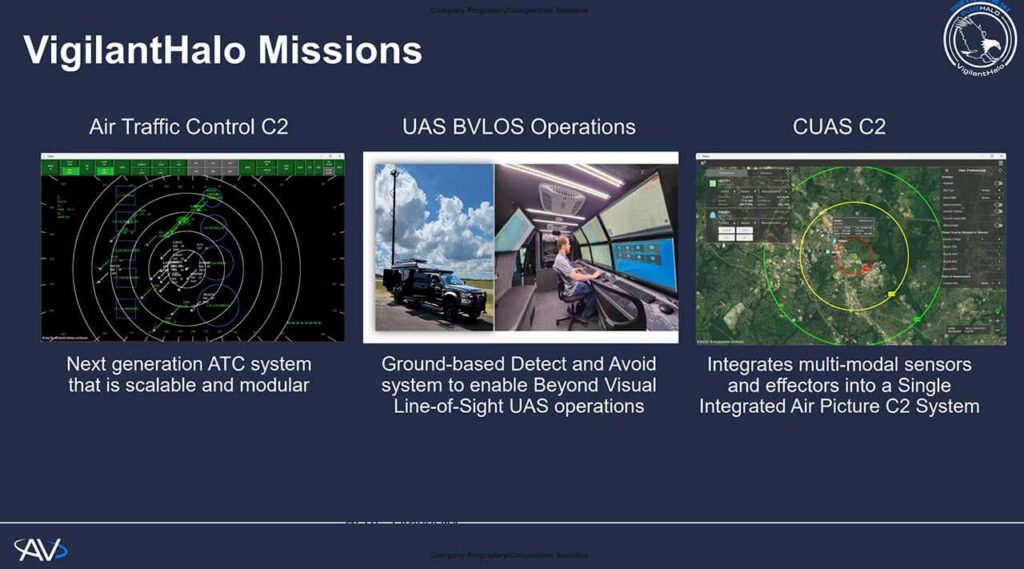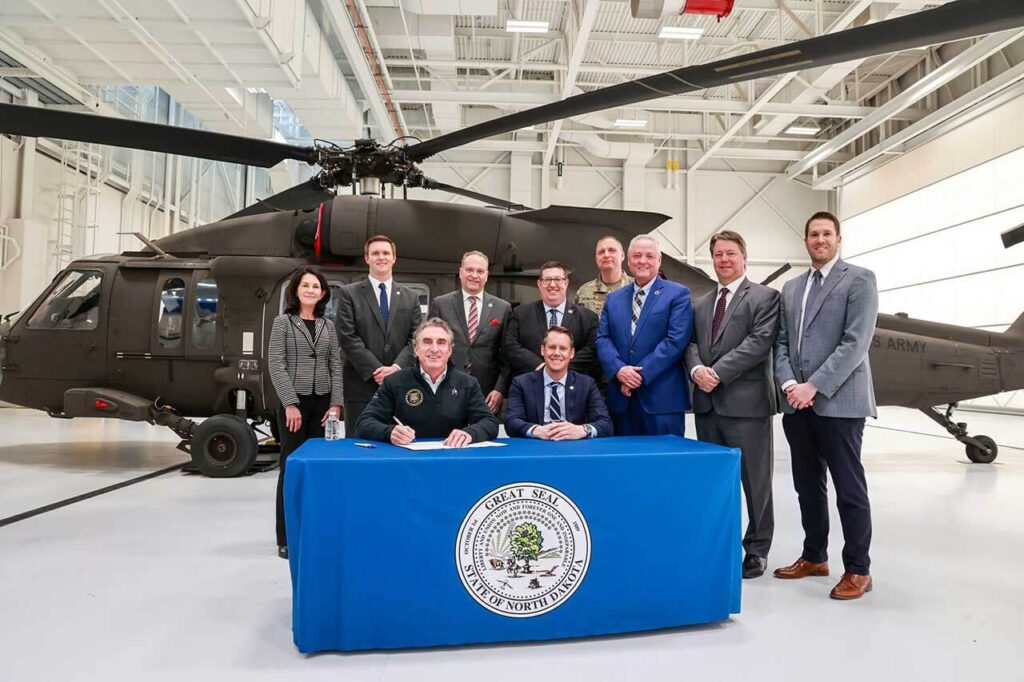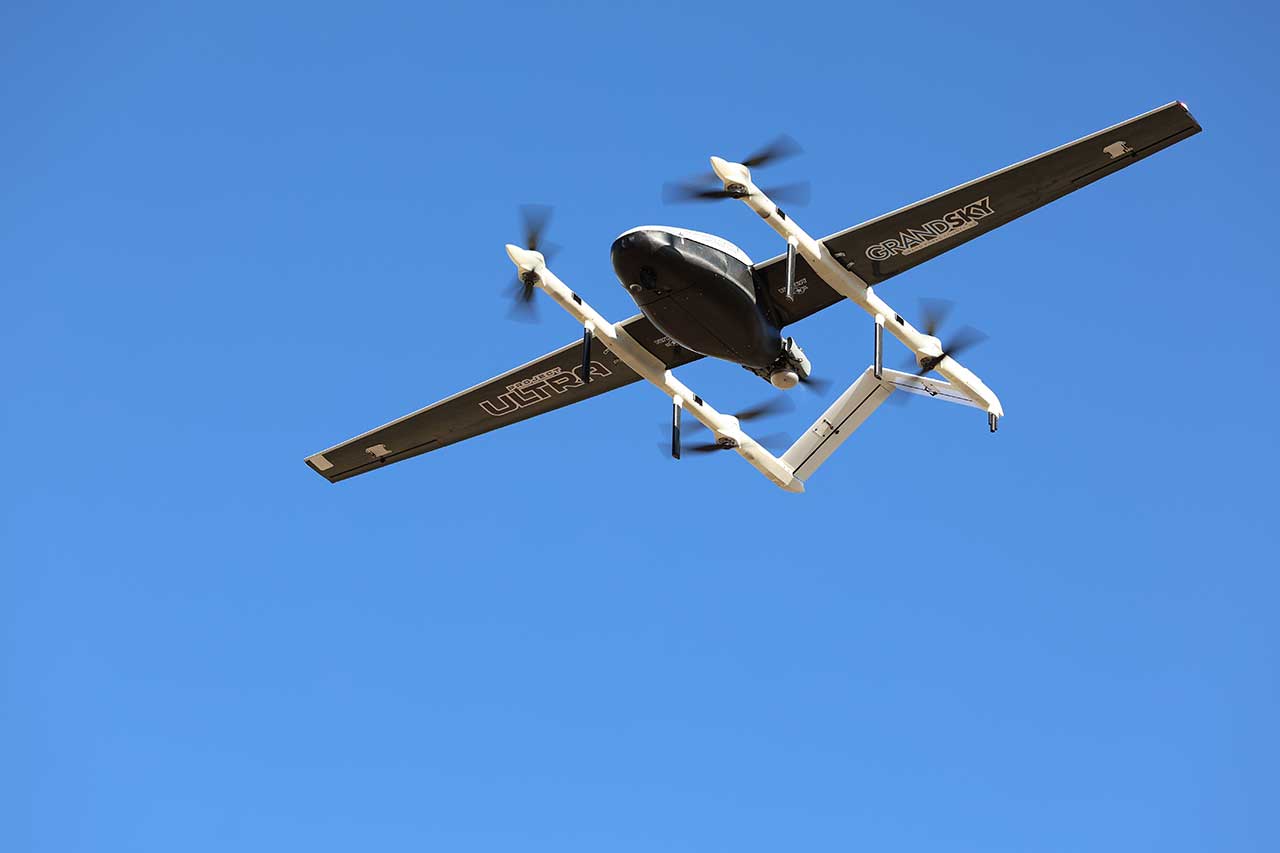Above the windswept prairies of North Dakota, emerging aviation technologies take flight. Two powerhouse organizations, GrandSKY, the nation’s first commercial unmanned aircraft systems (UAS) flight operations center, and AV, the newly unified company formed by the merger of AeroVironment and BlueHalo, have fused military-grade security with commercial innovation to form the core of these operations. Together, these teams continue to shape the future of secure, scalable drone operations through first-of-their-kind initiatives like Project ULTRA, the PANTHER program, and the integration of VigilantHalo for airspace command and control.
GrandSKY: Where Defense Meets Innovation
GrandSKY operates on a 217-acre site adjacent to Grand Forks Air Force Base. Leveraging a 50-year enhanced use lease with the U.S. Air Force, the facility’s joint use of a 12,000-foot runway and military-grade radar systems, combined with the region’s four-season climate, creates an ideal environment for rigorous UAS testing and operations.
Over the past decade, GrandSKY has become about more than just its infrastructure. It has evolved into a hub where government, academia, and industry converge to push the boundaries of what’s possible in UAS. The recent expansion of its BVLOS (beyond visual line of sight) operational area from 3,000 to 56,000 square miles—an area larger than the state of New York—demonstrates the scale of GrandSKY’s reach.

AV: Merging Agility and Expertise
The recent union of AeroVironment and BlueHalo into AV marks a new chapter in defense technology. AV brings together decades of experience in autonomy, robotics, aerospace, and counter-UAS solutions, all with a focus on agility and rapid innovation. Sean Troyer, Senior Vice President of RF CUAS Strategic Operations and a retired Army officer, described the company as “built for all-domain dominance,” delivering integrated capabilities “not just abroad, but here on the homeland”.
Program Manager Bryan Tisinger added that AV’s strength lies in its ability to respond quickly to evolving challenges. “Every few months there’s a new challenge out there, especially in the DoD (Department of Defense) space where everything’s changing. If you have a product that’s five or ten years old and you can’t update it or add new features, you’re not going to meet the never-ending needs. Our company has that agility,” he explained.
The Convergence: PANTHER, SkyRange, and the Seeds of Partnership
The collaboration between GrandSKY and AV began with the integration of advanced phased array technologies under the PANTHER program. This initiative, rooted in hypersonic missile tracking and telemetry, was developed in partnership with the Test Resource Management Center’s (TRMC) SkyRange program at GrandSKY. The technology’s dual-use nature—serving both defense and commercial needs for Low Earth Orbit (LEO) satellites—set the stage for deeper cooperation between the two organizations.
Troyer recounted how AV’s involvement with GrandSKY began and has grown over the past three years. “It didn’t really start with the civilian-controlled airspace or the military infrastructure. It started with the people. That’s what got us fired up about being there. We are all in on it. We understand GrandSKY is going to be the nexus of the autonomous universe for the DoD, and North Dakota is leading the way,” he explained.
Project ULTRA: A Blueprint for Secure, Scalable Drone Operations
The current GrandSKY-AV focus revolves around Project ULTRA—UAS Logistics, Traffic, Readiness, and Autonomy. Awarded as a five-year contract by the Office of the Secretary of Defense (OUSD), ULTRA aims to:
- Enable military Group 3 UAS to deliver goods between installations, flying BVLOS through the national airspace system (NAS)
- Demonstrate seamless integration of military and commercial UAS operations in real-world conditions
- Leverage modular, open systems for plug-and-play integration of advanced technologies
The project has moved into Task Order 3. Its upcoming milestone slated for this July will involve a series of real-world demonstrations from Grand Forks Air Force Base to Cavalier Space Force Station, a journey of about 50 nautical miles each way, using Skyways drones. This operation will traverse both Class D and E airspace and provide critical data on airspace management, aircraft performance, and system safety.

VigilantHalo: The Nerve Center for Secure Airspace
AV’s VigilantHalo, a software-driven integration platform for real-time command and control (C2) underpins ULTRA’s operations. Born out of a need to unify disparate sensors and data streams, VigilantHalo provides a single, actionable airspace picture for operators. Its core capabilities include:
- Ground-Based Detect and Avoid (GBDAA): Enables safe BVLOS operations by identifying and tracking all aircraft in the vicinity.
- Integrated Counter-UAS: Fuses data from RF, radar, acoustic, and other sensors to detect, track, and mitigate unauthorized drones.
- Modern Air Traffic Control: Designed to help the Air Force and other operators replace legacy systems with scalable, microservices-based solution
Unlike traditional systems, VigilantHalo is built on microservices which makes it adaptable and plug-and-play for rapid integration of new technologies. Tisinger described VigilantHalo as “scalable and adaptable—exactly what’s needed for the ever-changing DoD and commercial landscape”.
In Project ULTRA, VigilantHalo serves as both a situational awareness tool and a testbed for new sensors and counter-UAS technologies. It enables side-by-side comparisons, real-time data recording, and visualization for operators and stakeholders in support of both military and commercial applications. The upcoming demo flights will test VigilantHalo’s ability to provide situational awareness and airspace management while gathering data to inform both military and commercial BVLOS operations. The demonstrations are designed not just as proof-of-concept exercises, but as foundational steps toward routine, secure drone logistics and emergency response.
North Dakota: America’s Drone Innovation Hub
Beyond GrandSKY, North Dakota’s emergence as a hub for UAS innovation is no accident. The state’s proactive legislative approach, robust academic partnerships, and thriving industry ecosystem have created fertile ground for drone technology to flourish.
The state’s drone ecosystem extends from the legislature to the University of North Dakota, the Northern Plains UAS Test Site, and business accelerators like The Hive and UAS manufacturer Meadowlark Aircraft Company. Annual events like the UAS Summit bring together policymakers, industry leaders, and innovators to share best practices and chart the future of UAS.
As one example of local government UAS efforts, the state recently enacted a law—effective August 2025—establishing a Chinese drone buyback program for all state agencies. This move aims to replace over 350 Chinese-made drones, the vast majority of which are DJI, with NDAA-compliant alternatives, to strengthen supply chain security and cyber resilience.
Scott Meyer, GrandSKY’s Director of Engagement and a North Dakota State Senator, explained the motivation behind this legislative push. “The reason why we wanted to lead the charge on this mainly is supply chain issues. We used the NDAA as the driver…(for) the national security issues that come with this,” he said. He further noted, “We’re always looking at ways to make sure we’re doing what’s right for the nation. Someone had to kick the door down and get this started, so we were happy to do it.” According to Meyer, North Dakota stands ready to share its carrot-and-stick approach for proactive drone security with other states, to serve as a model for the nation.

The Next Chapter: Testing, Policy, and Expansion
GrandSKY is rapidly becoming a national leader for counter-UAS and BVLOS testing, attracting companies eager to validate their technologies in real-world conditions. AV, for its part, aims to bring VigilantHalo’s integrated airspace management to airports, critical infrastructure, and major events to demonstrate that counter-UAS can be done safely and effectively in the United States. The collaboration between the two is more than just a partnership—it’s a shining exemplar of dual-use security in the age of drones.
Looking beyond the July demonstrations, GrandSKY and AV remain ready to expand Project ULTRA, integrate new partners and technologies, and continue shaping policy and best practices for secure drone operations.
Troyer underscored the importance of collaboration to the future of these projects and to the industry in general. “Industry needs to do exactly what we’re doing right now—talking about it, partnering, and bringing together technology and policy,” he said. “If folks at GrandSKY and other places of critical infrastructure can have C2 systems that provide situational awareness and decision support, it’s just going to enable much better security. This is the time to do it.”
By integrating cutting-edge technology, fostering a collaborative ecosystem, and leading on policy, this team ensures that both the military and commercial sectors can operate safely, securely, and efficiently in the national airspace.
For those seeking to join the next wave of drone innovation, North Dakota—and this ULTRA dual-use security team—are setting the standard for what’s possible. Meyer captured the spirit of the project and the region: “We want people to come up here and see what’s going on. There’s something special here, and I just encourage everybody to come see it with your own eyes.” The future of secure, scalable drone operations is being written in North Dakota—don’t miss your chance to be part of it.
Watch Bryan Tisinger and Sean Troyer from AV and Scott Meyer of GrandSKY, on the Dawn of Autonomy.Interested in learning more or partnering with GrandSKY and AV? Connect with Scott Meyer on LinkedIn, or reach out to AV through their website.
By: Dawn Zoldi

